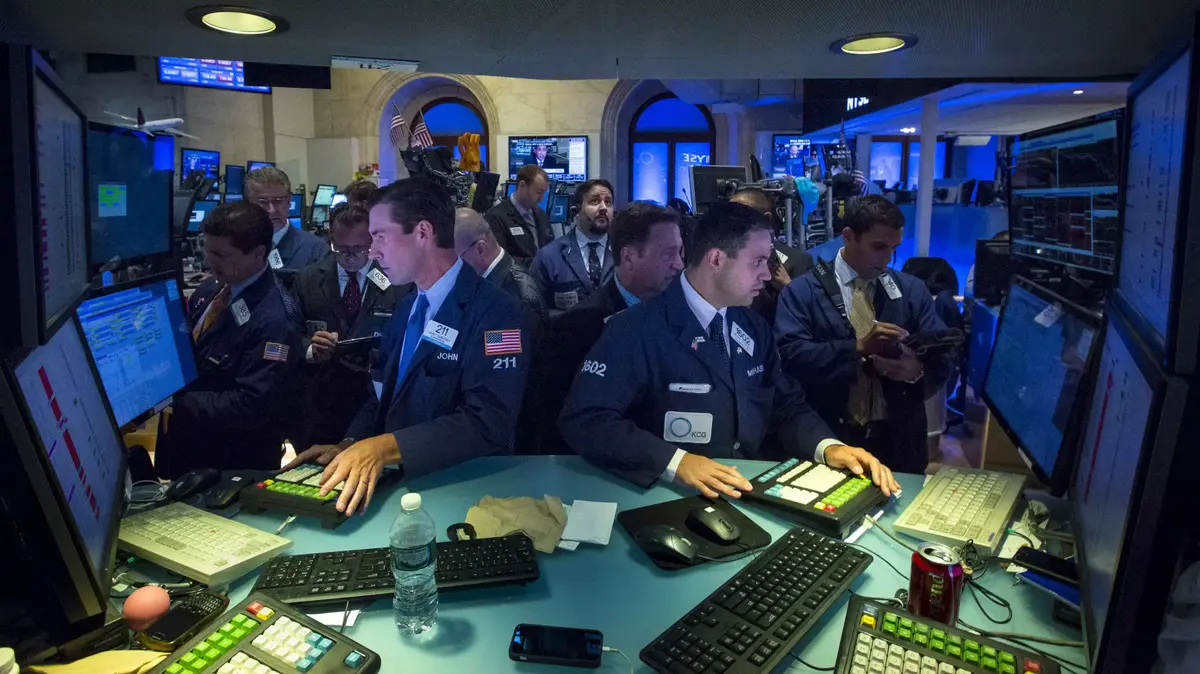The biggest legal fraud in the world: that's how companies distort their reports
The race to push stock prices up nonstop has resulted in a policy of growing companies above all, while endless acquisitions and mergers have enriched hundreds of thousands of entrepreneurs and investors, they have also burned trillions of dollars and destroyed millions of America's financialization workers - fifth article in the series
Since 1987, the beginning of financialization of America and the turning of the share price into the company's main product, dividends - the original idea behind the issue of shares to the public - have been shrinking, both totally and proportionally, of the total stock market returns. For 90 years, between 1871 and 1960, the average annual return on dividends from the S&P 500 companies did not fall below 3%. In 45 years of dividend content was over 5%, and in only three of the 30 years between 1960-1990 did the dividends fall below 3%.
Financialization of America - All Previous Series Articles »
■ Derivatives Market: This is how a $ 500 trillion casino is created
■ Thus, the transportation giant Uber has become a symbol of everything that has gone wrong in the US capital market
■ Inside the American Dream: The Most Billionaires Next to the Most Homeless
■ The death of veteran American icons: The Chronicle of the End is well known in advance
The sharp change began after Greenspan's "put option" in late 1987, when the celebration began. After the sharp fall in stock prices on Black Monday, October 19 of that year, the Fed's chairman, Greenspan, lowered interest rates, a policy that continued over the next few years, making stocks rise and prevent financial declines for the first time in history Central but not stated, for purposes of the Fed's interest rate policy.
And so while the average dividend between 1970 and 1990 was 4.03%, that between 1991 and 2007 fell sharply to 1.95%, and that from 2009 to 2015 to 1.99%. The 2019 estimate is that dividends will stand at about 1.8% out of a total expected return of about 30% on the investment in the S&P 500 stock.
In the Nasdaq index, things are even worse. Since 2014, the annual average dividend for companies paying this index has been 1.62%. The stock price has thus become the main target for dividend-less investors, and executives to whom most of their earnings are linked. A growth policy above all, a profitable company can hardly grow, and still continue to pay a nice and regular dividend, but a company that needs a steady increase in the share price constantly needs a "story."
Thus, the huge boom in acquisitions and mergers was born, most of which was intended to generate growth through acquisitions. For many reasons, acquisitions include a shortcut in adopting new technologies, a foothold in the market or a new product, receiving complementary products to an existing product line, and more. Surveys conducted by executives, such as the 2011 Accenture, showed that the main reason for making purchases (64%) was the desire to generate revenue growth. This compares with 38% who noted the acquisition of new technologies. (The survey could be named for more than one reason and therefore the overall result exceeded 100%).
Chronicle of failure
According to various publications, such as Harvard Business Rivio, between 70 and 90 percent of acquisitions and mergers end in failure. A study by "KPMG" calculated that the failure rate was 83%, but that did not reduce the phenomenon. And so, from $ 347 billion and 2,600 merger and acquisition deals in 1985, the world of acquisitions jumped to more than 45,000 deals and an average of $ 4 trillion per year since 2014, of which $ 1.6 trillion in the United States. From $ 750,000 mergers and acquisitions in excess of $ 55 trillion.
At the same time as the endless acquisitions and mergers, most of which failed to enrich hundreds of thousands of entrepreneurs, bankers and investors, they also burned trillions of dollars of resources and wreaked havoc on millions of workers. Not only in the world, but also in Israel there are some impressive examples: In 2000, "Chromatis" was sold in what was then the largest acquisition deal in Israel, for $ 4.8 billion. Managers and employees celebrated communicatively at a beachside party. No 18 months had passed and celebrating workers were looking for work and $ 4.8 billion of alleged value had evaporated. The buyer decided to "completely abandon the technology developed by Chromatis" and focus. The focus did not last long. Several months have passed and the buyer, "Lucent", a giant telecom company, has also begun to spin. Four more years passed and she merged with another company in the field, Alcatel. A few more years passed and Nokia's shriveled company was swallowed up.
"Chromatis" is no exception. Tens of thousands of purchases ended similarly. The pattern is familiar: technologies and companies that are bought with a lot of money and then not used; Companies, which acquire small companies, themselves collapse thereafter; Entrepreneurs and employees who praise them as inventors of medicine, only to discover that they have succeeded in making a successful exit for themselves and investors, but not much more than that - these have been commonplace since 1987.
What was special about "Chromatis" was the amount and speed, but the whole phenomenon is puzzling: Are the executives of those huge companies really as smart and worthy of the huge pay packages as they and their mouthpieces are trying to convince the world? Or did financialization just unfold before them a playground, a sort of adult monopoly game, where the tokens are billions in number?
"One-time opportunity"
Managerial wisdom and passion for such acquisitions has brought "Teva" down to depreciation and its investors for losses of billions of shekels. Teva has been one of the leading companies in the country for many years. Its board of directors sat the smart and experienced business executives, such as Galia Maor, CEO of Bank Leumi and Dan Proper, CEO of Assam and president of the Manufacturers Association. In July 2015, the company announced the major acquisition deal in the history of the Israeli economy, in exchange for about $ 40 billion, about 34 of which were cash and the rest in shares, was acquired by the Allergan generic pharmaceutical division (Equities). Following the announcement, Teva shares jumped by about 14% and almost all commentators in the media have finished praising the company and its executives. In a press release, the company said the motive for the acquisition was that "the deal will increase double-digit earnings per share in 2016, increasing earnings per share by 20% in the second and third years after the acquisition." Few people have noticed that the promise to increase earnings per share has not only eliminated nearly all of the company's cash balance, but has increased the company's debt by nearly $ 27 billion.
Five days after the acquisition, the general meeting of shareholders was asked to approve annual remuneration to each of the directors for approximately $ 190,000 per year, as well as a fee for attending meetings of $ 2,000 per meeting. "This is a one-time opportunity to create a $ 100 billion company," explained Nature.
Teva then managed to burn another $ 2.3 billion on the acquisition of a worthless drug company from Mexico. When the acquisition was completed, the CEO promised that "the increased cash flow would enable it to quickly pay off the financial debt." In December 2015, CEO Wigodman was named Man of the Year in the business sector and in September 2016, Acquits was awarded the "Business Move of the Year" title. No eighteen months have passed and the huge debt, over $ 35 billion, has begun to signal. The businessman of the year was sent home honored and this year's business move brought the company to the brink of bankruptcy.
New management was spearheaded and this began with attempts to save the company, and by the end of 2017, extensive layoffs began. Almost five years have passed since the acquisition and the share price - the goal of the entire move - has lost about 85% of its value and the company's future depends on heaven and earth.
Among other moves the new management took was to clear the company's financial statements. In the center of the clean-up, a huge $ 17 billion write-off of a property called Reputation is listed on the company's balance sheets. This reputation, which still had about 28 billion in balance at the end of 2017, was the cost of acquisitions, most notably Equities-Allergan. This is an accepted accounting practice. When acquiring another company, the acquired property is recorded in the acquirer’s books under the “goodwill” section. Since this is an asset purchase, the acquisition cost will not affect the income statement, but only the balance sheet, where the asset will be recognized as a goodwill. As a matter of fact, the decision to keep the asset in the company's books or to revalue it to its true economic value is a decision. It knows that a write-off or revaluation of the "goodwill" may damage the company's equity, and may even erase it entirely, and thus impair its credit rating and in its ability to obtain more loans.
Of course, this is not the only technique aimed at refurbishing and "rounding up" the financial data of companies. The practice that has become more standard and is gaining popularity is the one known as Non-GAAP reporting. Gap is the acronym for the words "Generally Accepted Accounting Principles" and these are the standards and rules by which public companies should prepare their financial statements. The non-gap reports were originally created to allow the company to present to the public and analysts its business results by eliminating special or one-off events, such as the cost of restructuring. These reports are not audited by the auditor and are a statement from the management in the style of "The reports say so and so but take into account that there were special or one-off expenses, so if we disable them our reports would look like this."
These reports are not reported to the Securities and Exchange Commission, but they are highly featured in press releases and investors and are also taken seriously by many analysts.
What was once a way to isolate a special and one-off event has, over the years, become the King's way of presenting financial data to investors, analysts and even employees. An in-depth audit conducted by the Audit Analyst found that 97% of companies in the S&P 500 used non-GAAP reports in 2017. By comparison, in 1996, the membership rate was 59%.
The investor is lost
Since 1986, the gaps between the financial results of the Gapp vs. Non-Gap reports of S&P 500 have jumped an average of 15 times. Or did it actually earn 220 million of "platform basic earnings" as the non-Gap reports solemnly stated.
In a lecture given by Jim Chan Investment Fund Manager at UC Berkeley in April 2019, entitled "In the Sunlight - Financial Statements in the Post-True Period", a series of common techniques in financial statements were presented today. For example, a "reorganization" that was considered a legitimate one-off expense for a canon-gap show became a way to hide current expenses. Large companies such as Kellogg and Qatpiler have also introduced "one-off" restructuring expenses each year since 2010. Another technique, widely accepted in Silicon Valley, is to include back the revenue recorded for employee share payments.
According to the GAAP, allotment of shares to employees is recorded in the statements as "non-cash compensation" expenses. The reason for this is simple, the allotted shares are a property of the company that can be sold on the market at full price but given free or reduced price. This is similar to the fact that the company would give its employees as a gift any other property, say real estate or products, without receiving payment for them. As Warren Buffett said, "If employee options are not a form of payment, what are they? If they are not an expense, what is it? And if the expense does not have to be considered among the company's expenses then how should it register? ".
This revision has a real impact on the reports. For example, at SailForce, between 60 and 65 percent of earnings per share, Non-Gap, resulted from the return of employees' shares back to the profit line. At Palo-Alto Networks, eliminating this expense made a significant contribution to reversing a loss of $ 0.62 per share, Gap, to $ 1.05 per share, Non-Gap.
Cheating or rounding corners
A study published in the Journal of Economics and Accounting in 2018 found that non-Gap reports have helped companies significantly meet Wall Street analysts' expectations, many of which receive such reports as part of their assessment of the companies. Jim Chanos today summarized what is happening in the financial statements world as "legal fraud, with companies significantly distorting their financial statements".
Direct fraud in financial statements or rounding corners? Reasonable misrepresentations or repairs? There is no doubt that the compilation of highly creative financial reports that are widely reported in the media, coupled with massive equity acquisitions by the companies, which are widely funded by debt, produce tremendous stock market manipulation. All of this sits on the Federal Reserve's promise since 1987 to intervene with printed money and low interest rates whenever markets seek to act as a free-real market and find out through the price mechanism the true value of companies - another result of a world in which the share price, rather than the business boom and the welfare of all the details involved in the economy , Became the main parameter and measure of its prosperity.
The writer is a lawyer with his education and technology involvement. Director of cryptographic currency investment fund, and has lived in Silicon Valley for 22 years. Writer of "A Brief History of Money" and KanAmerica.Com Podcast Recorder on Twitter: chanansteinhart @














